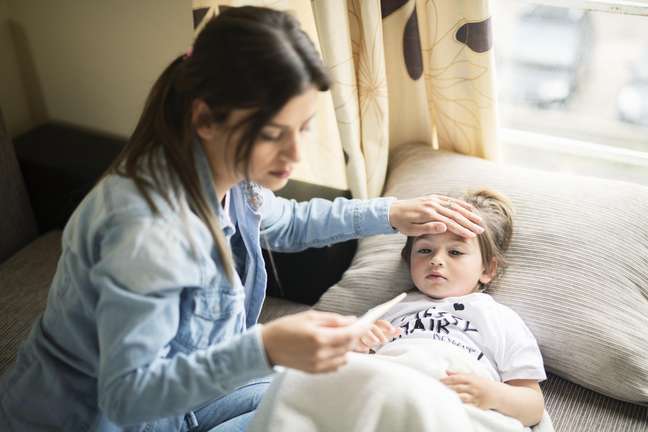Cough, stuffy nose, fever … These are the symptoms of various respiratory infections. Know when to go to the hospital and learn how to avoid the problem
Just arrive at the autumn / winter season and that’s it! begins to appear cough, sneezing, runny nose… Now, with the pandemic – which, it is always good to remember, is not over yet – worries have doubled. Is it Covid-19? Do I have to take the test? Although Sars-Cov-2 infection is indeed a cause for attention, there are many other common childhood respiratory diseases.

“It is possible to characterize acute respiratory infections as those that can lead to acute respiratory failure, a condition in which oxygen supplementation is required. They are the number one cause of hospitalization for children of any age.“explains pediatrician Rubens Cat, head of the Department of Pediatrics at the Hospital das Clínicas in Curitiba (PR).
Main respiratory diseases of childhood
According to the expert, they are:
Acute viral bronchiolitis
“In infants, who are children under the age of two, it is the leading cause of hospitalizations but has low mortality,” says the pediatrician. Most cases are due to contact with respiratory syncytial virus (RSV) and rhinovirus.
Pneumonia
The most serious and with the highest risk of mortality. “It is the leading cause of non-external death [ não causada por intervenções, como homicídio ou acidentes] in children “, underlines Rubens. According to information from the World Health Organization (WHO), every 39 seconds a child dies of pneumonia in the world. Study data released by the United Nations Children’s Fund (Unicef) predict that 6.3 million children could lose their lives as a result of the problem by 2030.
Acute viral croup
Croup is a term used for various respiratory infections in children, resulting from inflammation of the upper and lower airways. Symptoms include hoarseness and a characteristic strong cough. Severe cases require hospital treatment.
exacerbation of asthma
Motivated by airway virus infection, respiratory syncytial virus (RSV) and rhinovirus are the most common. “How Asthma is the most common chronic disease in children and adolescentsits exacerbation is the main cause of hospitalizations in childhood and adolescence “, explains the doctor.
When to go to the emergency room?
The symptoms of most of these diseases – and many others that affect the respiratory tract – can be very similar. But how to differentiate, for example, a flu or a common cold from something more serious, such as bronchiolitis or even pneumonia, which in some cases requires urgent treatment?
“Signs of severity requiring medical attention are: very rapid and rapid breathing, bluish discoloration around the mouth and extremities – which is cyanosis -, moaning, extreme irritability, sleepiness, inconsolable babies even in the breast, sagging of the neck region and between the ribs, known as stretching, and throbbing of the wing of the nose [quando as narinas se alargam, abrindo e fechando várias vezes]. If the child already knows how to speak, he will probably say that he has difficulty breathing “, specifies the pediatrician.

An important point that usually causes a lot of doubts in families is a fever. This is one of the scariest symptoms, especially for first-time parents. Despite this, the recommendation is to remain calm and observe. ” Fever is not a sign of severity for any of these conditions. and it shouldn’t be a reason to go to the emergency room right away, “guides the doctor.” If the child is relatively well when he has a fever and accepts at least the ingestion of fluids, he can stay at home and wait up to three days. ” says., there is time to make an appointment with a trusted pediatrician. “With this approach it is possible to avoid up to 70% of the search for emergency rooms, as well as the use of unnecessary drugs, especially antibiotics”, says the specialist .
If necessary, to relieve discomfort, talk to your child’s doctor and administer an antipyretic in the prescribed dosage and frequency.
How to prevent respiratory diseases in children
It is common for children to have seven to ten cold episodes a year. However, some measures help prevent or mitigate infections:
- Invest in breastfeeding and a healthy diet with fruits and vegetables
- Follow the vaccination schedule for the child and all adults in the family
- Keep rooms airy and allergen-free
- Stimulate outdoor activities
- Maintain zero tobacco in the house
- Do good hand hygiene
- Having adequate time and quality sleep
- Encourage good water intake
- Carry out daily hygiene of the nostrils with saline solution
- Keep up with the periodic consultations with the pediatrician
- avoid agglomerations
- Wear masks inside (children should continue to wear them in classrooms)
Do home remedies work?
Tea, homemade syrups, honey… Can grandma’s recipes, handed down from generation to generation, really help prevent and treat children’s respiratory diseases? The answer is yes! “Home treatments are very useful for airway infections such as flu, colds, throat and ear infections and rhinosinusitis, but this does not cause breathing difficulties“, Rubens Cat guide.
“Nasal hygiene is essential, as is the intake of plenty of fluids. Honey relieves coughs with phlegm, but beware: it can only be used in children over 18 months of age,” he explains. This is due to the risk of contamination by bacteria that cause botulism, a food poisoning that affects the nervous system.

Social isolation x respiratory diseases
More than two years after the pandemic, contact with the viruses has decreased, which may also have reduced or delayed the body’s readiness for common diseases. “What we have seen is a increased frequency of these infectionsespecially in children born during the pandemic and in those who previously did not attend schools and nurseries, “says the doctor.” They are practically always with some symptoms, such as cough, runny nose, obstruction, fever, among others. Prolonged isolation may have decreased or made their defenses not as effective against traditionally benign and not long-lasting and repeated viral infections.“, explains the pediatrician.
“For most of these conditions, there is no indication for the use of antibiotics, which undoubtedly was the main one [ problemas de saúde causados por má conduta médica] to the emergency room, which can lead to serious complications, “he points out.
Covid-19: we are still in the pandemic
The truth is, the coronavirus continues to deserve our attention, even with children. Initially, the little ones were not as affected or suffered less from symptoms. On the other hand, some of them constitute one of the few groups still not eligible for vaccination, the most effective form of protection against the disease.
“We are in a moment of less seriousness, but with an increasing number of cases. The more cases there are, the increase in hospitalizations, complications and deaths is inevitable, because it is a matter of common sense and mathematical equivalence,” he says. the specialist. .
In addition to preventing contamination and severe forms of the disease, reducing hospitalizations and deaths, the vaccine also mitigates the risk of the most feared, serious and still rare complication of Covid-19 in childhood, the Multisystem Inflammatory Syndrome, which has already affected 1,781 children in Brazil, with 117 deaths, sequelae and chronic symptoms. “Pediatricians and pediatric societies play a fundamental role in enlightening parents and reassuring them about the efficacy and need to vaccinate as many children as possible, as quickly as possible, to protect our greatest asset, which is our children. and grandchildren “. the doctor.
Source: Terra
Benjamin Smith is a fashion journalist and author at Gossipify, known for his coverage of the latest fashion trends and industry insights. He writes about clothing, shoes, accessories, and runway shows, providing in-depth analysis and unique perspectives. He’s respected for his ability to spot emerging designers and trends, and for providing practical fashion advice to readers.







